牛津译林版七年级下Unit 4 Finding your way第四课时课件(24张ppt)
文档属性
| 名称 | 牛津译林版七年级下Unit 4 Finding your way第四课时课件(24张ppt) | 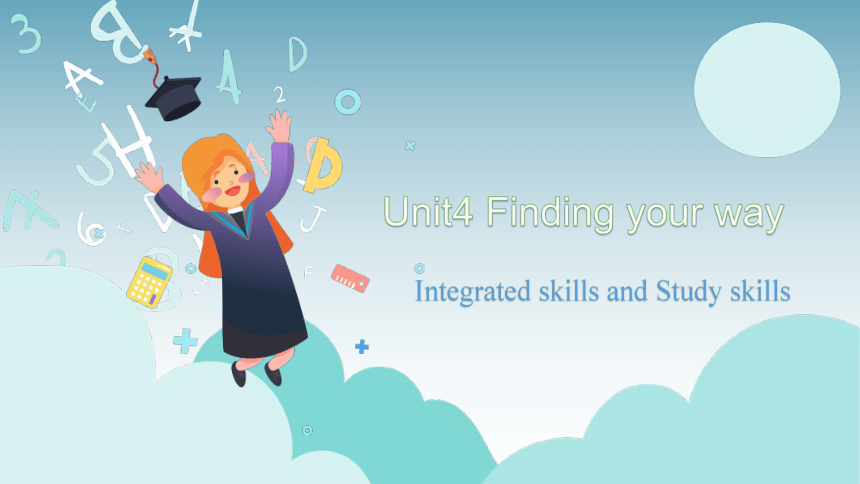 | |
| 格式 | zip | ||
| 文件大小 | 2.1MB | ||
| 资源类型 | 教案 | ||
| 版本资源 | 牛津译林版 | ||
| 科目 | 英语 | ||
| 更新时间 | 2022-02-07 10:13:24 | ||
图片预览

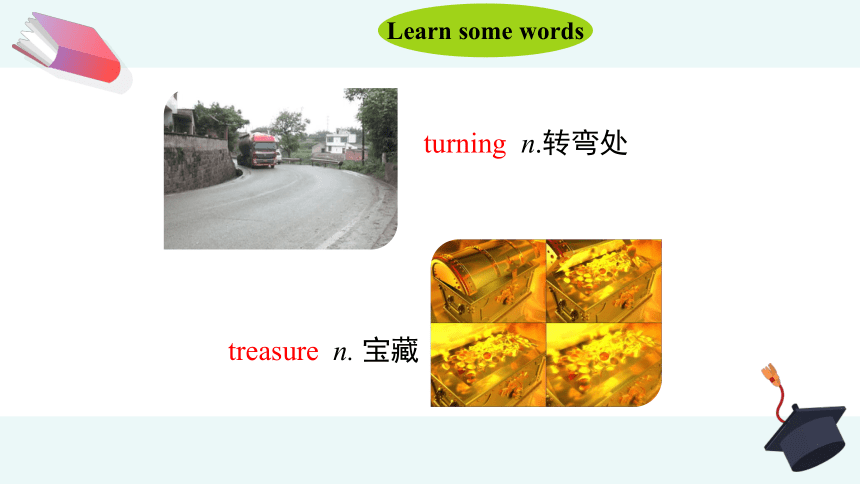

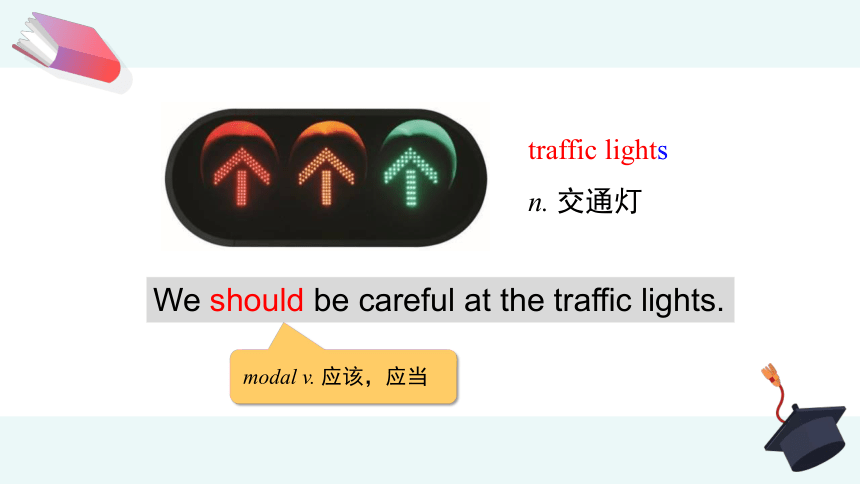

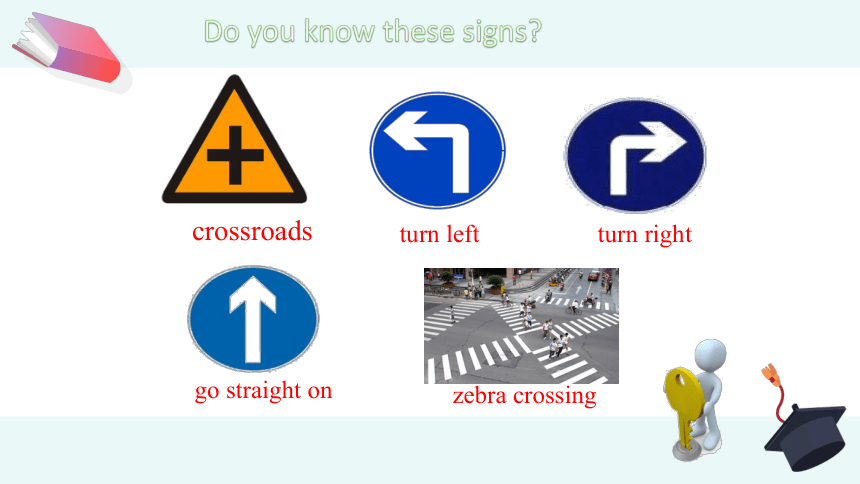
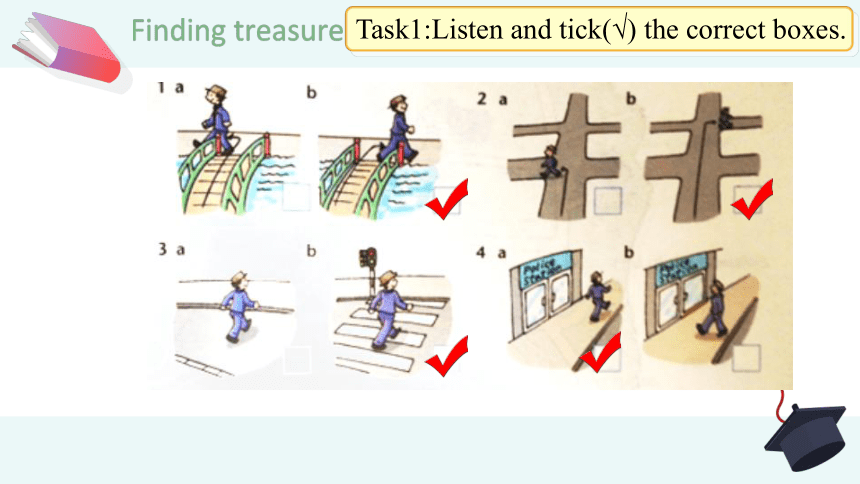
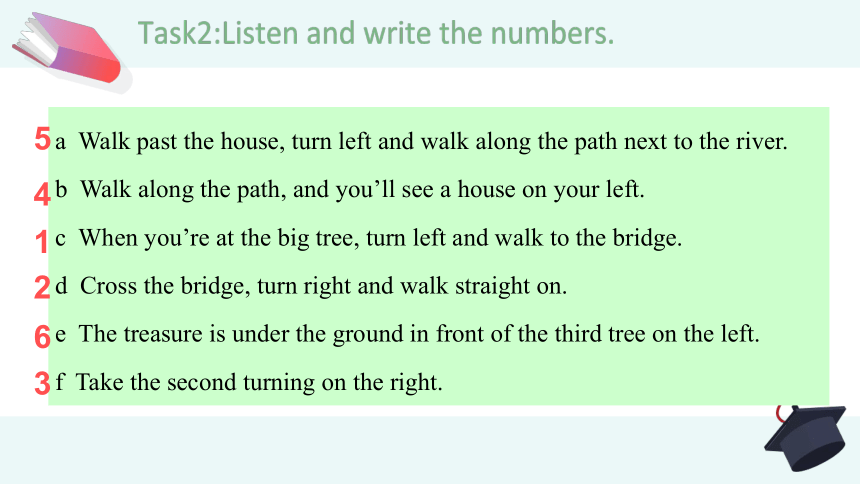
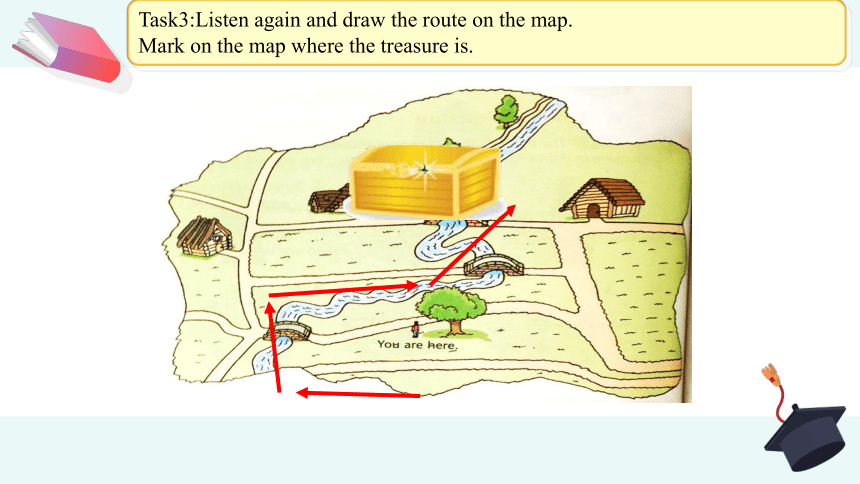
文档简介
(共24张PPT)
Unit4 Finding your way
Integrated skills and Study skills
Learn some words
turning n.转弯处
treasure n. 宝藏
traffic n. 交通,来往车辆
There is a lot of traffic on the road.
traffic lights
n. 交通灯
We should be careful at the traffic lights.
modal v. 应该,应当
crossing n. 交叉路口
corner n. 拐角,街角;角落
Do you know these signs
crossroads
turn left
turn right
go straight on
zebra crossing
Finding treasure
Task1:Listen and tick(√) the correct boxes.
Task2:Listen and write the numbers.
a Walk past the house, turn left and walk along the path next to the river.
b Walk along the path, and you’ll see a house on your left.
c When you’re at the big tree, turn left and walk to the bridge.
d Cross the bridge, turn right and walk straight on.
e The treasure is under the ground in front of the third tree on the left.
f Take the second turning on the right.
1
2
4
5
6
3
Task3:Listen again and draw the route on the map.
Mark on the map where the treasure is.
Task2: Fill in the blanks
Millie: Hi, Daniel. There's an English Corner at Sunny Garden this Saturday afternoon. Would you like to come
Daniel: Yes, I'd love to. _____________________________
Millie: You can walk there from your building. Go out and turn left. ____________________________________________
Daniel: Which way should I go at the traffic lights
Millie: __________________________________________
___________________________ Then you'll see Sunny Garden at the corner of the street.
Daniel: Thanks, Millie. See you there.
How do I get there
Walk straight on, and you'll see the traffic lights.
Just cross the road. Walk past the supermarket and
turn left at the first crossing.
1. Walk past the house, turn left and walk along the path next to the river.
走过这座房子,向左转,沿着河边的小路走。
解析:past,介词,意为“在另一边,到另一侧”。walk past为动词短语,意为“走过”,相当于动词pass。
如: I walk past the Xinhua Bookshop on my way to school.我在上学的路上步行经过新华书店。
辨析:past与pass
词条 含义 用法
past 介词,意为“经过;超过” 与动词walk, go, run等连用作谓语
pass 动词,意为“通过;传递" 指在人或物前面或旁边经过,可单独作谓语使用
如: ---What's the time now 现在几点了 ---It's half past twelve. 12点30分。
He passes the book to me. 他把书递给了我。
拓展:past作名词时,意为“过去,往事”;作形容词时,意为“过去的,以前的”。
如: We can't forget the past. 我们不能忘记过去。
The past year is very important to me.过去的一年对我来说很重要。
2. Take the second turning on the right. 在第二个拐角处向右拐。
解析:此句型结构为“Take the +序数词 +turning on the left/right.”,
相当于“Turn left/right at the +序数词 +turning.”。
原句相当于“Turn right at the second turning.”。turning,名词,意为“转弯处”,动词形式为turn,意为“转,拐弯”。
如: Take the first turning on the left.= Turn left at the first turning.
在第一个拐弯处向左拐。
Take the third turning on the right.在第三个拐弯处向右拐。
提醒:turning一般指“拐弯处”,而表示“十字路口”用crossing。
3. How do I get there 去那儿的路怎么走
解析:此句为问路交际用语,表示问路的常用句型还有:
问路的句型 Excuse me, where is...
Can you tell me the way to...
Which is the way to...
Can you tell me how to get to...
How canI get to...
如: Can you tell me the way to the railway station from the park 你能告诉我从公园到火车站的路吗
拓展:
指路的句型 Go/ Walk along/ down the road.
Go straight on.
Tum right/ left into.../at the...
Walk on until you get to...
You can see...on your right/left.
4. Walk straight on, and you'll see the traffic lights. 一直往前走,你会看到红绿灯。
解析:traffic名词,意为“交通,来往车辆”,为不可数名词。
如: There is too much traffic on the road. 道路上来往车辆太多。
拓展:
含traffic的短语 traffic accidents交通事故
traffic jam交通堵塞
traffic rules交通规则
如: His left knee was hurt in a traffic accident. 他的左膝在一次交通事故中受伤了。
Everyone should obey traffic rules. 每个人应该遵守交通规则。
5. Then you'll see Sunny Garden at the corner of the street. 然后你会看到阳光花园在街道的拐角处。
解析:corner名词,意为“拐角,街角;角落”;at the corner of意为“在...的拐角处”。
如: When you get to the corner of the road, you'll see a cinema. 当你到达马路的拐角处,你就会看到一家电影院。
辨析:at the corner of,in the corner of与on the corner of
短语 含义 用法
at the corner of 在...的拐角处 一般指路、街道的拐角
in the cornerof 在...的角落里 一般指室内的角落
on thecorner of 在...的角落上 一般指物体的表面或边缘
如: She is waiting for the bus at the corner of the street. 她正在街道的拐角处等公交车。
There is a football in the corner of the room. 房间的角落里有一个足球。
I hit my knee on the corner of the desk. 我的膝盖撞到了课桌的桌角。
There is a path between the hills.
2. Pandas are cute.
When we speak, we drop our tone at the end of a statement.
When we ask a yes / no question, our tone rises at the end of the question.
Are there any lions
Is the zoo far away from our school
Study skills: Falling tone and rising tone
When we ask a wh-question, our tone usually falls at the end of the question.
1. What can you see across the bridge
2. How do I get there
We make our tone rise at the end of a sentence to show surprise.
Simon: The zoo is about three kilometres away from our school.
Daniel: There kilometres
英语有两种基本的语调:升调和降调。
1)升调: 升调多用来表示“不肯定”和“未完结”的意思,
比如一般疑问句,语气婉转的祈使句,以及用陈述句子形
式表示疑问的各类句子。
2)降调: 降调表示“肯定”和“完结”。
一般用于陈述句、特殊疑问句、命令句和感叹句中。
Conclusion
Can you find the rule
Millie: Hi Sandy. Tomorrow is Saturday.
Would you like to go and see a film
Sandy: Yes, I’d like to. Which cinema do you want to go to
Millie: The one at Sunshine Shopping Mall.
Sandy: Sunshine Shopping Mall
Millie: Sure. We can go shopping there too.
Practice
Read the conversation below. Put a falling arrow or a rising arrow at the end of each sentences.
Sandy: Good idea. When shall we meet
Millie: Is 2 p.m. OK
Sandy: All right. See you then.
6. All right. See you then. 好的。到时见。
解析:all right意为“行了,可以”,表示同意对方的建议或要求。有时还可以表示“身体很好”。
如: ---Please tell me about it. 请把此事告诉我。---All right. 好吧。
Is your mother all right 你妈妈身体好吗
辨析:“That's right. ”与“That's all right.
(1) “That's right.” 意为“对的。”,表示赞同对方的意见、看法或行为,肯定对方的答案或判断。
如: ---I think we must help the old man. 我想我们必须帮助这位老人。
---That's right. / You re right. 说得对
(2) “That's all right.” 意为 “不用谢。”或“没关系。”,用来回答对方的致谢或道歉。
如: Many thanks. 多谢。
That's all right. 不用谢。
---Sorry. It's broken. 对不起。它坏了。---That's all right. 没关系。
Exercise
一、用适当的介词填空
1. Guangdong is south ______ Jiangsu.
2. There is a stone bridge ______ the river.
3. There is a hotel ______ the corner of my street.
4. Turn right ______ the first crossing.
5. We prepare some money ______ the trip.
6. Do you go to work ______ bus
7. Which is the way ______ the zoo
Exercise
一、用适当的介词填空
1. Guangdong is south ______ Jiangsu.
2. There is a stone bridge ______ the river.
3. There is a hotel ______ the corner of my street.
4. Turn right ______ the first crossing.
5. We prepare some money ______ the trip.
6. Do you go to work ______ bus
7. Which is the way ______ the zoo
of
over
on/at
at
for
by
to
Unit4 Finding your way
Integrated skills and Study skills
Learn some words
turning n.转弯处
treasure n. 宝藏
traffic n. 交通,来往车辆
There is a lot of traffic on the road.
traffic lights
n. 交通灯
We should be careful at the traffic lights.
modal v. 应该,应当
crossing n. 交叉路口
corner n. 拐角,街角;角落
Do you know these signs
crossroads
turn left
turn right
go straight on
zebra crossing
Finding treasure
Task1:Listen and tick(√) the correct boxes.
Task2:Listen and write the numbers.
a Walk past the house, turn left and walk along the path next to the river.
b Walk along the path, and you’ll see a house on your left.
c When you’re at the big tree, turn left and walk to the bridge.
d Cross the bridge, turn right and walk straight on.
e The treasure is under the ground in front of the third tree on the left.
f Take the second turning on the right.
1
2
4
5
6
3
Task3:Listen again and draw the route on the map.
Mark on the map where the treasure is.
Task2: Fill in the blanks
Millie: Hi, Daniel. There's an English Corner at Sunny Garden this Saturday afternoon. Would you like to come
Daniel: Yes, I'd love to. _____________________________
Millie: You can walk there from your building. Go out and turn left. ____________________________________________
Daniel: Which way should I go at the traffic lights
Millie: __________________________________________
___________________________ Then you'll see Sunny Garden at the corner of the street.
Daniel: Thanks, Millie. See you there.
How do I get there
Walk straight on, and you'll see the traffic lights.
Just cross the road. Walk past the supermarket and
turn left at the first crossing.
1. Walk past the house, turn left and walk along the path next to the river.
走过这座房子,向左转,沿着河边的小路走。
解析:past,介词,意为“在另一边,到另一侧”。walk past为动词短语,意为“走过”,相当于动词pass。
如: I walk past the Xinhua Bookshop on my way to school.我在上学的路上步行经过新华书店。
辨析:past与pass
词条 含义 用法
past 介词,意为“经过;超过” 与动词walk, go, run等连用作谓语
pass 动词,意为“通过;传递" 指在人或物前面或旁边经过,可单独作谓语使用
如: ---What's the time now 现在几点了 ---It's half past twelve. 12点30分。
He passes the book to me. 他把书递给了我。
拓展:past作名词时,意为“过去,往事”;作形容词时,意为“过去的,以前的”。
如: We can't forget the past. 我们不能忘记过去。
The past year is very important to me.过去的一年对我来说很重要。
2. Take the second turning on the right. 在第二个拐角处向右拐。
解析:此句型结构为“Take the +序数词 +turning on the left/right.”,
相当于“Turn left/right at the +序数词 +turning.”。
原句相当于“Turn right at the second turning.”。turning,名词,意为“转弯处”,动词形式为turn,意为“转,拐弯”。
如: Take the first turning on the left.= Turn left at the first turning.
在第一个拐弯处向左拐。
Take the third turning on the right.在第三个拐弯处向右拐。
提醒:turning一般指“拐弯处”,而表示“十字路口”用crossing。
3. How do I get there 去那儿的路怎么走
解析:此句为问路交际用语,表示问路的常用句型还有:
问路的句型 Excuse me, where is...
Can you tell me the way to...
Which is the way to...
Can you tell me how to get to...
How canI get to...
如: Can you tell me the way to the railway station from the park 你能告诉我从公园到火车站的路吗
拓展:
指路的句型 Go/ Walk along/ down the road.
Go straight on.
Tum right/ left into.../at the...
Walk on until you get to...
You can see...on your right/left.
4. Walk straight on, and you'll see the traffic lights. 一直往前走,你会看到红绿灯。
解析:traffic名词,意为“交通,来往车辆”,为不可数名词。
如: There is too much traffic on the road. 道路上来往车辆太多。
拓展:
含traffic的短语 traffic accidents交通事故
traffic jam交通堵塞
traffic rules交通规则
如: His left knee was hurt in a traffic accident. 他的左膝在一次交通事故中受伤了。
Everyone should obey traffic rules. 每个人应该遵守交通规则。
5. Then you'll see Sunny Garden at the corner of the street. 然后你会看到阳光花园在街道的拐角处。
解析:corner名词,意为“拐角,街角;角落”;at the corner of意为“在...的拐角处”。
如: When you get to the corner of the road, you'll see a cinema. 当你到达马路的拐角处,你就会看到一家电影院。
辨析:at the corner of,in the corner of与on the corner of
短语 含义 用法
at the corner of 在...的拐角处 一般指路、街道的拐角
in the cornerof 在...的角落里 一般指室内的角落
on thecorner of 在...的角落上 一般指物体的表面或边缘
如: She is waiting for the bus at the corner of the street. 她正在街道的拐角处等公交车。
There is a football in the corner of the room. 房间的角落里有一个足球。
I hit my knee on the corner of the desk. 我的膝盖撞到了课桌的桌角。
There is a path between the hills.
2. Pandas are cute.
When we speak, we drop our tone at the end of a statement.
When we ask a yes / no question, our tone rises at the end of the question.
Are there any lions
Is the zoo far away from our school
Study skills: Falling tone and rising tone
When we ask a wh-question, our tone usually falls at the end of the question.
1. What can you see across the bridge
2. How do I get there
We make our tone rise at the end of a sentence to show surprise.
Simon: The zoo is about three kilometres away from our school.
Daniel: There kilometres
英语有两种基本的语调:升调和降调。
1)升调: 升调多用来表示“不肯定”和“未完结”的意思,
比如一般疑问句,语气婉转的祈使句,以及用陈述句子形
式表示疑问的各类句子。
2)降调: 降调表示“肯定”和“完结”。
一般用于陈述句、特殊疑问句、命令句和感叹句中。
Conclusion
Can you find the rule
Millie: Hi Sandy. Tomorrow is Saturday.
Would you like to go and see a film
Sandy: Yes, I’d like to. Which cinema do you want to go to
Millie: The one at Sunshine Shopping Mall.
Sandy: Sunshine Shopping Mall
Millie: Sure. We can go shopping there too.
Practice
Read the conversation below. Put a falling arrow or a rising arrow at the end of each sentences.
Sandy: Good idea. When shall we meet
Millie: Is 2 p.m. OK
Sandy: All right. See you then.
6. All right. See you then. 好的。到时见。
解析:all right意为“行了,可以”,表示同意对方的建议或要求。有时还可以表示“身体很好”。
如: ---Please tell me about it. 请把此事告诉我。---All right. 好吧。
Is your mother all right 你妈妈身体好吗
辨析:“That's right. ”与“That's all right.
(1) “That's right.” 意为“对的。”,表示赞同对方的意见、看法或行为,肯定对方的答案或判断。
如: ---I think we must help the old man. 我想我们必须帮助这位老人。
---That's right. / You re right. 说得对
(2) “That's all right.” 意为 “不用谢。”或“没关系。”,用来回答对方的致谢或道歉。
如: Many thanks. 多谢。
That's all right. 不用谢。
---Sorry. It's broken. 对不起。它坏了。---That's all right. 没关系。
Exercise
一、用适当的介词填空
1. Guangdong is south ______ Jiangsu.
2. There is a stone bridge ______ the river.
3. There is a hotel ______ the corner of my street.
4. Turn right ______ the first crossing.
5. We prepare some money ______ the trip.
6. Do you go to work ______ bus
7. Which is the way ______ the zoo
Exercise
一、用适当的介词填空
1. Guangdong is south ______ Jiangsu.
2. There is a stone bridge ______ the river.
3. There is a hotel ______ the corner of my street.
4. Turn right ______ the first crossing.
5. We prepare some money ______ the trip.
6. Do you go to work ______ bus
7. Which is the way ______ the zoo
of
over
on/at
at
for
by
to
